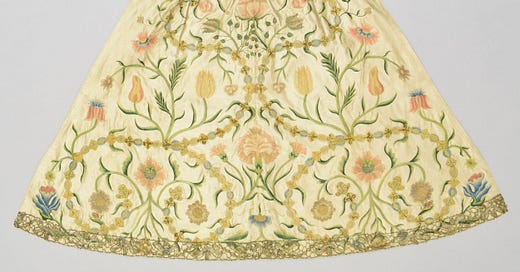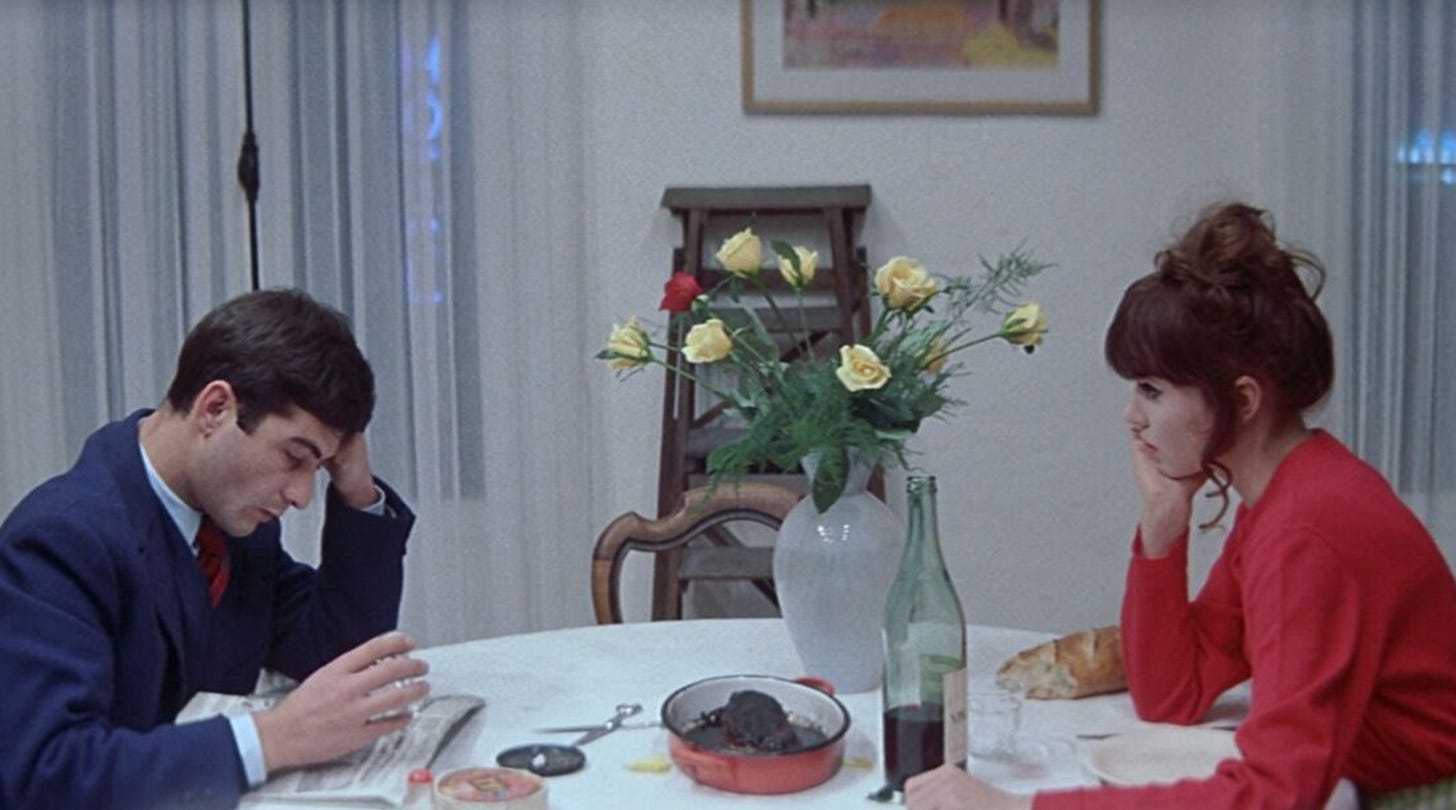A fascinating phenomenon I’ve noticed in fashion history is the transformation of a utilitarian garment into something wholly frivolous, its central purpose morphing from practical to decorative. I can’t find a better example than the apron. Arguably human’s first ever garment, aprons can be traced to the beginnings of man (and woman). For the sake of the story, I’m going to ask you to imagine Adam and Eve for a second, sorry. According to Genesis 1:1–2:4, God created Adam and Eve to tend his garden. They could eat from every tree except the tree of life, God being a gatekeeper of good and evil and the mysteries of the universe etc. But Eve was a woman i.e. curious, greedy, selfish, a little dumb...a tree full of secrets was humming before her and she was expected to not go forth? She ate from the tree of life after being urged by the evil serpent, and with her womanly wiles, convinced Adam to eat too. Thus, the pair was suddenly aware of their nakedness and covered themselves with fig leaves. And the apron was born alongside the human race.1
Belief in Christian Genesis or no, humans have donned a kind of apron or loin cloth for centuries to cover and protect you-totally-know-what. It wasn’t until the Middle Ages when the contemporary concept of the apron emerged. The term stems from the French word ‘nappe’ meaning ‘tablecloth’. The British did what they do best and mispronounced the word for so long that it turned into an entirely new word, ‘naperon’. After many centuries of being pronounced as ‘a_naperon’ the thing itself became known as ‘apron’…‘an_apron’.2 Cool.
It doesn’t take a rocket scientist, or even a wannabe fashion historian, to guess that aprons were used by working people of many professions in the Middle Ages, not just house-bound cooks and servants. Women hunched over spluttering kettles and male cobblers mending leather goods alike. Life was dirty and the average person did not have clothing to spare; an apron was a practicality to protect your working and living dress.

Over time, aprons would come to embody something greater than their practical use. When I imagine the concept now, my mind immediately goes to the housewife: Betty Draper with a porcelain face, bouncing blond curls, and an apron performing its duty.
Last week I saw A Woman is a Woman at Film Forum, according to Wikipedia, a “1961 French experimental musical romantic comedy written and directed by Jean-Luc Godard”. It was witty and beautiful to look at, and features a lot of lighthearted relationship conflict between the main character, Angela, who is a cabaret dancer yearning for motherhood, and her fussy noncommittal boyfriend, Emile. They sit before a burnt roast dinner that Angela prepared, and she sulks because Emile won’t entertain the only thing she asks of him, a baby. Through the most gorgeous pout you’ve ever seen, she utters, ‘women suffer so much’. To which he replies, ‘women are the cause of all suffering’. Angela’s pout remains fixed, the argument finished. She huffs away without touching the roast, angrily removing her apron.
Despite Angela being a confident woman who possesses a supposed sexual freedom as a cabaret dancer (i.e. she’s nude at work and she seems to enjoy that), her time and happiness remain fused with her boyfriend’s needs, moods, etc. By 1961, women in France did not have legal access to any method of contraception, like the pill or IUD. Women lived relatively modern lives, and yet bodily autonomy remained restricted, one could argue as a punishment. Angela hurries home after her mid-day shift (she emerged onstage in a sailor uniform which she deftly removed while singing about how beautiful she was), ties her apron tightly around her cinched waist and prepares a meal, albeit inedible, for Emile. Six thousand years have passed, give or take, and woman still bears the mark of Eve’s original sin. Conceal what is evil, suffer in turn, put on the apron and cook for your boyfriend who isn’t that cute anyway!
For all the negativity, if not plain indifference surrounding the apron as a garment, it’s role in fashion history is long and nuanced. Women being inclined to embellish and signify greater meaning with their dress has given the apron its storied past and recent rejuvenation. Alongside the maids and blacksmiths of the middle ages are the well-to-do classes who had little use for a scrap of worn fabric about the waist; and still, among the various reputable costume archives around the world, we see thousands of examples of beautifully designed and very gently worn aprons.
According to the Victoria and Albert Museum, aristocratic and upper-to-middle class women have been wearing finely worked linen aprons since the 16th century. And, because the linens were so delicate and the women so refined, historians have3 concluded that these early aprons were never intended to serve the wearer as protection from spills and splatters. Rather, a woman might wear a floor-length apron embellished with floral cut-work to symbolize her role as an accomplished wife and mother. The fine detail and pristine condition would reveal her status and add an extra layer of pretty to her outfit - 5 centuries later not so much has changed.
A later example, the below is an apron from the late 1800s, notable for its intricate floral embroidery and integration of sequins and metallic threads.4
Women turned something that was at best utilitarian, at worst punishing, into something beautiful. Here are a few favorites from my research:
As much as I’d love to say I thought this up on my own,
can be credited for my most recent bout of inspiration. She reached out to me as I landed in Kentucky for Christmas with a photo for an apron she thought maybe I could make. As a follower so deftly commented, it has no functionally practical use whatsoever; rather, it looks cool (imo) and adds a lot of textural/colorful interest to an outfit. I had never seen anything like it and didn’t have the words for what techniques were used to make it. So I brainstormed and came up with her (let’s call it the Juliana for ass-kissing sake):Lately I’ve been seeing aprons, loosely defined please note, everywhere. From peplum waist cinchers like this from Deiji Studios to the Missoni look-alike I found on EBay for Kate’s birthday. The term has completely metamorphosized in my mind and provides an exciting opportunity to accessorize in a completely useless way. And the best news is you can find some incredible vintage options online, no need to source someone to handmake you one unless you really love the Juliana and absolutely have to have one for yourself ;) (in which case, dm me).
Whether you don an apron within the confines of your kitchen, or you choose to bend the rules and accessorize for the sake of accessorizing, know that you are part of living history and the ladies of the 17th c. would love your ingenuity ;) ;) ;)
I loved this project, I loved this research, and I love you for reading.
XOXO,
Isabel
The Bible wtf
Ask me about the origins of the word ‘tennis’ PLEASE
Apron, 1580-1600, https://collections.vam.ac.uk/item/O113936/apron-unknown/
Apron, Hungarian, fourth quarter 19th century, https://www.metmuseum.org/art/collection/search/157841













More historical deep dives into things pls!! ;););)
Your brain! Your talent! ❤️